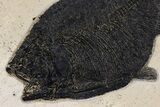This Specimen has been sold.
20" Monster Fish Fossil (Phareodus) - Wyoming
This is a monster 20" long Phareodus from the Green River Formation of Wyoming. This whopper was collected this summer from the Lindgren Quarry near Kemmerer, Wyoming. It has dark black preservation which contrasts nicely against the light colored shale and features amazing detail. Just check out its mouthfull of chompers. The preparation on this piece is excellent with only some minor restoration to the tips of the fins and a small area on the front of its head.
The specimen has a wood backing plate and wall mounting hardware installed, so it is ready to be hung on a wall. A stunning display which is sure to turn heads.
The specimen has a wood backing plate and wall mounting hardware installed, so it is ready to be hung on a wall. A stunning display which is sure to turn heads.
About Phareodus
Phareodus is a genus of predatory freshwater fish found in the famous Fossil Lake deposits of the Green River Formation in Wyoming. It had a mouthful of sharp pointy teeth, making it a voracious lake predator. In fact, the name Phareodus actually means "to have teeth". Spines from other fish such as Mioplosus and Priscacara have frequently been found preserved in their stomachs.
Phareodus is a genus of predatory freshwater fish found in the famous Fossil Lake deposits of the Green River Formation in Wyoming. It had a mouthful of sharp pointy teeth, making it a voracious lake predator. In fact, the name Phareodus actually means "to have teeth". Spines from other fish such as Mioplosus and Priscacara have frequently been found preserved in their stomachs.
About Fossil Lake
50 million years ago, in the Eocene epoch, these fish thrived in Fossil Lake, which was fed by the Uinta and Rocky Mountain highlands. The anoxic conditions at the bottom of Fossil Lake slowed bacterial decomposition, prevented scavengers from disturbing corpses, and, most interestingly, suffocated creatures that ventured into the oxygen-starved aquatic layer. The result is a miraculous exhibition of Eocene biota: a subtropical aquatic community within sycamore forests, teeming with creatures such as freshwater stingrays, dog-sized horses, menacing alligators, early flying bats, and one of the first primates.
50 million years ago, in the Eocene epoch, these fish thrived in Fossil Lake, which was fed by the Uinta and Rocky Mountain highlands. The anoxic conditions at the bottom of Fossil Lake slowed bacterial decomposition, prevented scavengers from disturbing corpses, and, most interestingly, suffocated creatures that ventured into the oxygen-starved aquatic layer. The result is a miraculous exhibition of Eocene biota: a subtropical aquatic community within sycamore forests, teeming with creatures such as freshwater stingrays, dog-sized horses, menacing alligators, early flying bats, and one of the first primates.
SPECIES
Phareodus sp.
LOCATION
Lindgren Quarry, Kemmerer, Wyoming
FORMATION
Green River Formation
SIZE
20" long on 28 x 20" rock
CATEGORY
SUB CATEGORY
ITEM
#240208
We guarantee the authenticity of all of our specimens.
 Reviews
Reviews














